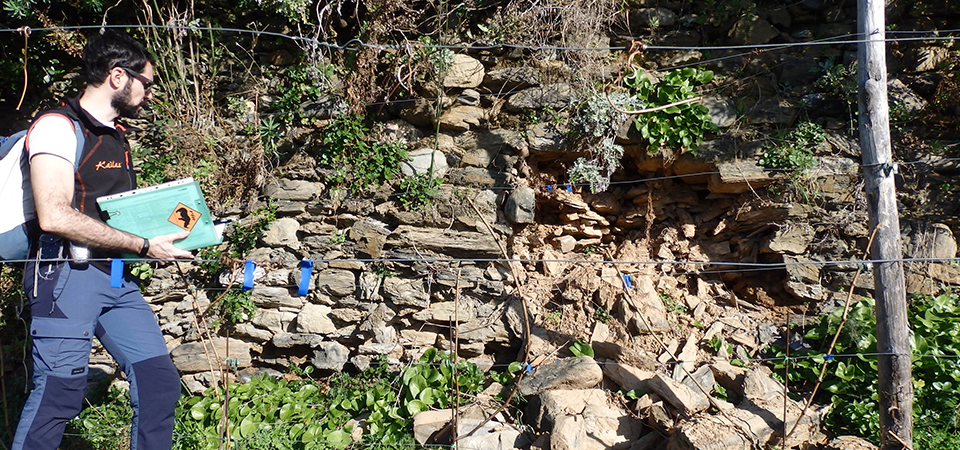
A park at the forefront of climate change mitigation
08/05/2020
Stone walls in western Liguria
17/11/2020by Ludovica Schiaroli
The University of Genova plays a key role in the Stonewallsforlife project. Its main tasks include carrying out all research activities and networking the knowledge and experience of the DISTAV (Department of Earth, Environment and Life Sciences) with the aim of understanding how it is possible to make this technique more resistant and effective to counteract the climate-change effect.
The project is coordinated by Professor Marco Firpo, while Andrea Vigo and Andrea Mandarino, both DISTAV’s research fellows, work “in the field”.
“First of all, we have started an overall analysis to delineate in detail the geological and geomorphological setting of the project area – Firpo explains – since it was necessary to understand how drystone walls are distributed and in what conditions they are, to indicate the interventions to be carried out”.
Fortunately, a solid base of data was already available, thanks to the work that the Manarola Foundation has been carrying out in the area since 2011, that consists of mapping property and, where possible, also intervening locally with the restoration of drystone wall parts.
The project will become fully active from the scientific point of view after the site investigation and the drystone walls mapping phase. In fact, four monitoring stations will be activated to collect meteorological data and geotechnical parameters related to the reworked soil retained by drystone walls, such as grain size, porosity, and groundwater conditions.
But how do the monitoring stations look like and how do they work?
“The support consists of a rod driven into the ground up to about 1-2 m depth, on which a control unit with a SIM card and powered by a solar panel is positioned – Firpo explains. This control unit is connected to several sensors that allow soil data at different depth and meteorological data to be collected and transmitted in real-time. This equipment is being furtherly developed in particular to investigate the surficial erosion process over the pilot site.
Obviously, there are technical times: in order to have representative data, the investigation period must be at least one year long.
The overall data will be processed and studied by the University of Genova aiming to find solutions to make drystone walls more stable and resistant to rainfall made increasingly intense by climate change.
To simplify, we can say that when we see deformed walls it means that there is a problem caused by the push of the water behind the wall, which can ultimately result in the collapse of the structure. Certainly, the lack of maintenance due to farmland abandonment and heavy rainfall are the main causes of the state of degradation that characterizes many drystone walls in the present day.
The physiographical setting of the Cinque Terre – with its slopes overlooking the sea – makes it a particularly fragile area and the drystone wall can, once again, play an important role. “The drystone wall did not only have the aim to recover more land to cultivate, but it was above all a way to reduce the denudation on these very steep slopes, where everything happens with great intensity”, Firpo concludes.
The work carried out by the University of Genova is important not only to safeguard the Cinque Terre landscape but also to become a relevant case study for further researches. This is the case of the Department of Barcelona in Catalonia, international partner of the project with a key role in the replication of the project in other areas of the European Union.
“We are already working with them – the professor says – and we have had a first “virtual” meeting to help them analyzing their site from the geological and geomorphological point of view, as done in Manarola”.
“Unfortunately, after the first field surveys the work has stopped due to the Covid19 emergency, but it will soon start again” – the professor assures adding that in these months of lockdown the study activities have continued and now everything is ready to return to the fieldwork.





